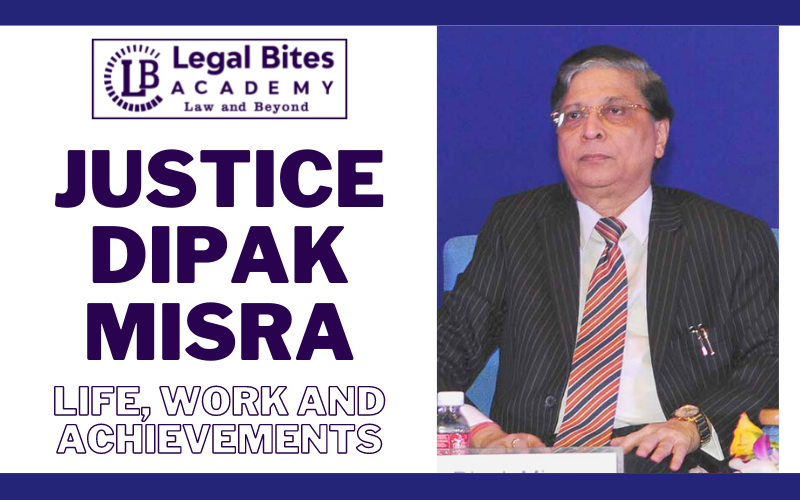Justice Dipak Misra: Life, Work and Achievements
This article titled ‘Justice Dipak Misra: Life, Work and Achievements.’ is written by Eshanee Bhattacharya and discusses the life, work and achievements of Justice Dipak Misra. I. Early Life of Justice Dipak Misra Justice Dipak Misra was born on October 3, 1953, and is an Indian Judge who served as the country’s 45th Chief Justice from August 28, 2017,… Read More »

This article titled ‘Justice Dipak Misra: Life, Work and Achievements.’ is written by Eshanee Bhattacharya and discusses the life, work and achievements of Justice Dipak Misra.
I. Early Life of Justice Dipak Misra
Justice Dipak Misra was born on October 3, 1953, and is an Indian Judge who served as the country’s 45th Chief Justice from August 28, 2017, to October 2, 2018.
Justice Ranganath Misra, who served as the 21st Chief Justice from 1990 to 1991, was his uncle. CJI Dipak Misra’s grandpa, Godabarish Misra, was a great independence fighter and one of the “five architects of modern Odisha,” a group of five friends and activists known as the “panchasakha.”[1] In 1928, he founded the Congress of India’s Odisha chapter.
II. A career in the Law
He was admitted to the Indian Bar Council on February 14, 1977, and practised in the Orissa High Court and the Service Tribunal in constitutional, civil, criminal, revenue, service, and sales tax matters. He was admitted to the bar on February 14, 1977, and practised in the Orissa High Court and the Service Tribunal in constitutional, civil, criminal, revenue, service, and sales tax matters. On the 17th of January, 1996, he was appointed as an Additional Judge of the Orissa High Court, and on the 3rd of March, 1997, he was transferred to the Madhya Pradesh High Court[2].
He was appointed Chief Justice of the Patna High Court in December 2009 and served until May 2010, when he was named Chief Justice of the Delhi High Court. On October 10, 2001, he was elevated to the Supreme Court.
Justice Misra served as Chief Justice of India for thirteen months, from August 28, 2017, when he was appointed as the 45th Chief Justice of India, to his mandatory retirement at the age of 65 on October 2, 2018, when he was succeeded by Ranjan Gogoi.
III. Contributions in the legal arena
1. Mukesh and Anrs. v. NCT Delhi (Nirbhaya Case)[3]
In 2012, India was shaken by the gruesome Delhi gang-rape case, which sparked fierce protests and focused attention on sexual assaults against women. The rape of a 23-year-old paramedical student horrified the country, prompting the government to form a judicial committee to draught tough anti-rape legislation. As a result, criminals were prosecuted more quickly and received a harsher punishment.
In May 2017, CJI Dipak Misra sentenced the four defendants to death, observing that “wanton lust” and “servility to utterly unchained carnal desire and bestiality” commanded their thoughts. In his decision, he stated: “The casual manner with which she was treated and the devilish manner in which they played with her identity and dignity is humanly inconceivable. It sounds like a story from a different world where humanity has been treated with irreverence.”
2. Yakub Abdul Razak Memon v. State Of Maharashtra, Thr. The Secretary, Home Department[4]
This case resulted in one of the most remarkable Supreme Court hearings ever. Justices Dipak Misra, PC Pant, and Amitava Roy began hearing a plea seeking to postpone Yakub Memon’s execution at 3:24 a.m. The request was dismissed unanimously, and the key suspect in the 1993 Mumbai serial explosions was executed. The bombings that targeted the Bombay Stock Exchange, a five-star hotel, Air India offices, and popular bazaars resulted in the convictions of eleven persons. Only Memon’s death sentence was upheld; the other ten defendants were condemned to life in prison.
3. Indian Young Lawyers Association v. State of Kerala[5]
The Sabarimala judgement was a watershed moment in Indian judicial history, advancing the cause of gender justice and eliminating religious practises that seek to discriminate among individuals based on ancient rules.
The Supreme Court abolished a restriction on women and girls between the ages of 10 and 50 from accessing the famous Sabarimala temple in Kerala on September 28, ruling that the centuries-old Hindu religious practise was illegal and unconstitutional.
In a 4-1 decision, the Constitution bench led by Chief Justice Dipak Misra found that the existing restriction is gender discrimination and that the practise violates the rights of Hindu women.
4. Navtej Singh Johar v. Union of India[6]
The Supreme Court overturned IPC Section 377, which made homosexuality illegal. The five-judge Constitution bench, led by Chief Justice Misra and including Justices Rohinton Fali Nariman, AM Khanwilkar, DY Chandrachud, and Indu Malhotra, overturned the colonial-era statute with a unanimous decision. Certain sexual practises were classified as “unnatural offences” under the 157-year-old statute, which were punished by a 10-year prison sentence.
While delivering the judgement, CJI Misra stated that criminalising gay sex is “irrational, indefensible, and manifestly arbitrary,” and that the LGBT community has the same rights as any other citizen. He claimed that Section 377 had been utilised to harass people.
Thus Justice Misra has been very instrumental in contributing to the constitutional aspect and his progressive views in his judgements have provided justice to the coming generations.
References
[1] Today, I. (2018). Prabhash K Dutta. [online] India Today, Available Here.
[2] CJI Dipak Misra early life, notable judgment, awards, achievements in the judiciary. [online] Latestgkgs.com. Available Here, [Accessed 12 Oct. 2021].
[3] [(2017) 6 SCC 1]
[4] Writ Petition (crl.) 129 of 2015
[5] 2018 SCC OnLine SC 1690
[6] (2018) 10 SCC 1

